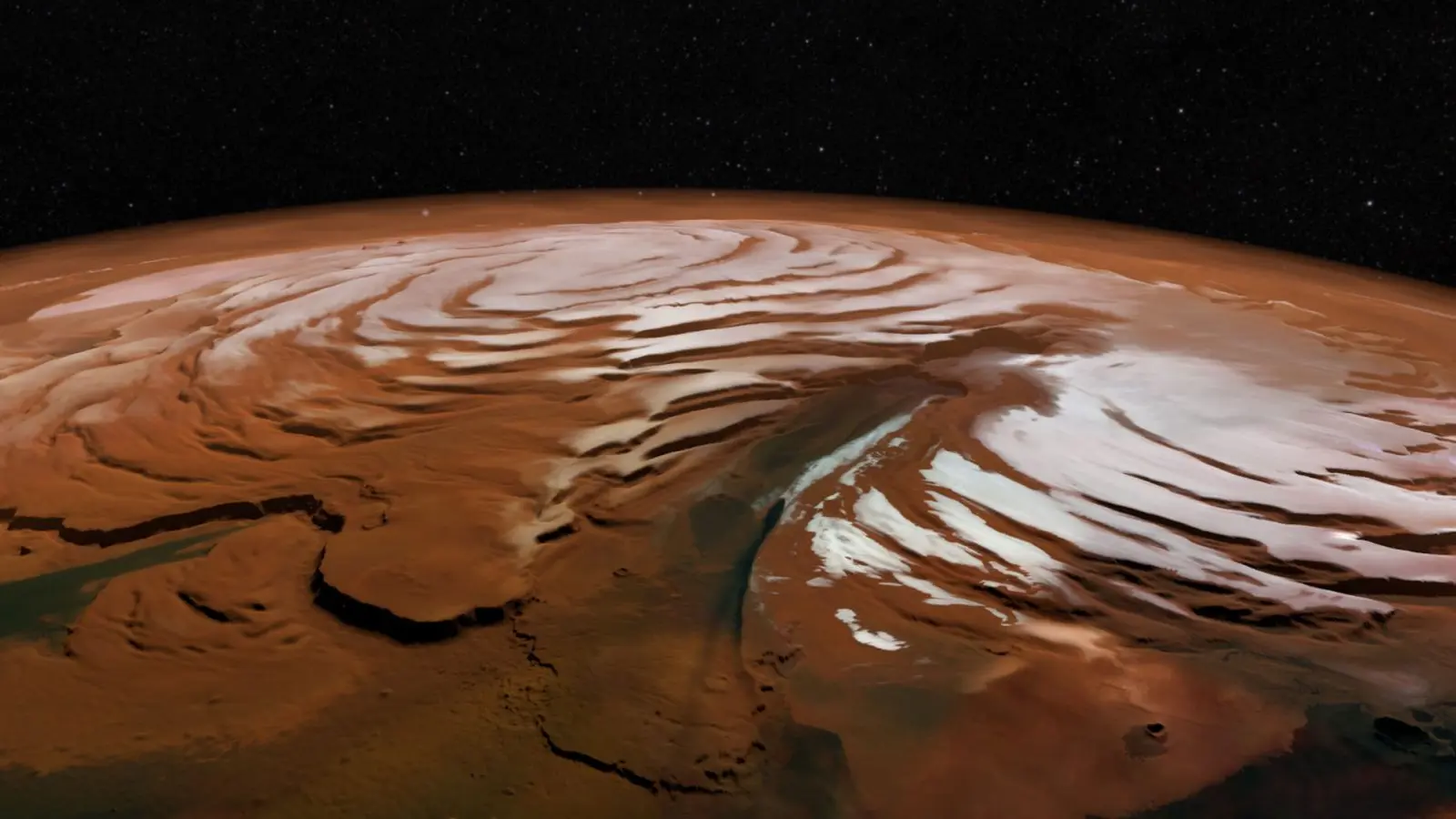6 Minutes
Rare observations of Mars’s winter polar vortex
A view of the north pole of Mars, created by taking images as seen by the European Space Agency’s Mars Express spacecraft and applying topographic data from the Mars Orbiter Laser Altimeter that was on board NASA’s now defunct Mars Global Surveyor mission.
Remote sensing of Mars’s north polar region has revealed unexpectedly extreme conditions inside the planet’s winter polar vortex, including a pronounced surge in atmospheric ozone. New analyses combining data from the European Space Agency’s Trace Gas Orbiter (TGO) and NASA’s Mars Reconnaissance Orbiter (MRO) show that temperatures within the vortex can be tens of degrees Celsius colder than surrounding air, and that the prolonged polar night enables ozone concentrations to build up.
Scientists led by Dr. Kevin Olsen (University of Oxford) presented these findings at the EPSC-DPS2025 Joint Meeting in Helsinki. By comparing limb-viewing measurements from TGO’s Atmospheric Chemistry Suite (ACS) with temperature profiles from MRO’s Mars Climate Sounder (MCS), the team isolated conditions inside the vortex and tracked chemical changes that occur when sunlight is absent for extended periods.
How the polar vortex forms and why it matters
Mars’s polar vortex is a seasonal feature, driven by the planet’s 25.2-degree axial tilt. As in Earth’s high latitudes, the end of northern summer ushers in a long polar night. The absence of solar heating causes a strong circumpolar wind structure — the polar vortex — that traps air and isolates the polar column from lower latitudes.
.avif)
A schematic of temperature measurements shows how it is 40 degrees Celsius colder inside the north polar vortex (indicated by the yellow line) compared to outside the vortex. Credit: Kevin Olsen (University of Oxford) et al.
Inside the Martian vortex, the atmosphere from the surface up to roughly 30 kilometers altitude becomes exceptionally cold — roughly 40 °C colder than air outside the vortex, according to the analysis. That intense cooling drives even the small quantity of water vapor present on Mars to condense and deposit onto the polar ice cap. This depletion of atmospheric water vapor alters the chemistry of the polar atmosphere in ways that favor ozone accumulation.
Ozone chemistry in Mars’s polar night
On Mars, ozone (O3) is a reactive oxygen species that acts as a tracer of photochemical and catalytic processes in the atmosphere. Under sunlight, photochemical reactions produce and destroy ozone in a dynamic balance. One important ozone sink involves interactions between ozone and hydrogen-bearing species derived from water vapor; when water vapor is present and exposed to UV radiation, it enables chemical pathways that break down ozone.
During the polar night, however, two things happen simultaneously: UV-driven photolysis essentially stops, and water vapor is removed from the gas phase as it condenses onto the ice cap. Without the usual photochemical destruction pathways that depend on water-derived radicals, ozone can accumulate inside the vortex. The net result observed by TGO/ACS was a measurable ozone surge relative to adjacent, sunlit latitudes.
Understanding the magnitude and variability of ozone in Mars’s atmosphere offers more than a snapshot of current chemistry. Ozone abundance and distribution inform models of atmospheric evolution, including how protective layers may have changed over geological time. If Mars once maintained a thicker ozone shield, surface environments would have experienced lower ultraviolet fluxes, which has direct implications for the survival or emergence of surface life in the planet’s past.
Methods: combining instruments to probe polar night
Probing Mars’s polar night requires coordinated use of different orbital instruments. TGO’s ACS measures absorption of sunlight as it grazes the limb of the atmosphere during occultations — a very sensitive way to identify molecular species and their vertical distribution. However, ACS needs sunlight passing through the atmosphere to perform limb spectroscopy, so total darkness over the pole makes continuous sampling impossible.
To work around this limitation, Olsen’s team used thermal and infrared temperature profiles from MRO’s Mars Climate Sounder to identify when and where the polar vortex structure temporarily deforms and lets sunlight penetrate at its limb paths. MCS temperature drops provided a clear marker for vortex interiors; matching those intervals with ACS occultations flagged observations taken inside versus outside the vortex. The cross-instrument approach enabled a reliable picture of the polar chemical environment during windows of partial illumination.
Implications for missions and future research
These findings matter for both atmospheric science and planetary exploration. The European Space Agency’s planned ExoMars Rosalind Franklin rover (currently scheduled for launch in 2028) targets signs of past life on Mars. Determining whether Mars once had a substantial ozone layer helps constrain surface radiation conditions over time and refines where and when the surface may have been hospitable.
The observations also highlight the value of sustained, multi-instrument monitoring from orbit. Instruments like TGO/ACS and MRO/MCS are complementary: ACS provides detailed composition measurements, while MCS supplies the temperature context needed to interpret those chemistry signals under variable atmospheric dynamics.
Expert Insight
"These observations are an excellent example of how combining temperature mapping with composition measurements opens new windows into seasonal chemistry on Mars," says Dr. Elena Marquez, a planetary atmospheric scientist (fictional) with experience on thermal-infrared remote sensing. "The ozone buildup inside the polar vortex tells us that even subtle changes in water vapor and sunlight can flip the balance of key chemical cycles — information that is crucial when we reconstruct Mars’s atmospheric history and assess past habitability."
Conclusion
The discovery of an ozone surge within Mars’s winter polar vortex underscores how extreme cold and prolonged darkness reshape atmospheric chemistry on the Red Planet. By integrating data from TGO’s Atmospheric Chemistry Suite and MRO’s Mars Climate Sounder, researchers have a new handle on how water vapor condensation, lack of UV photons, and vortex dynamics combine to produce local ozone enhancements. These insights refine models of Mars’s past environment and inform future missions that aim to evaluate the planet’s potential to have supported life.
Source: scitechdaily


Leave a Comment